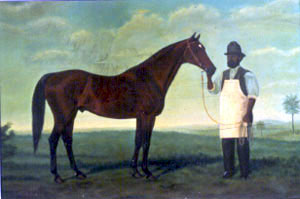
Thoroughbred Horse Breeding and Racing
As early as 1790, a number of thoroughbred stallions were brought into the Watauga and Holston settlements, and between 1790 and 1795, the Knoxville Register and Star Gazette advertised at least nine stallions as standing in what is now East Tennessee. Tradition says that the first thoroughbred stallion brought into Middle Tennessee was Grey Medley. This stallion stood the 1800 season at the Gallatin Road farm of William Donelson, a brother of Rachel Jackson, and for several years thereafter at the farm of Dr. R. D. Barry in Sumner County. Part of this farm was later Walter O. Parmer’s Edenwold Stud, one of the few thoroughbred horse nurseries still operating in Tennessee in 1910.
In Andrew Jackson’s day, the Tennessee Thoroughbred had no superior in the United States. General Jackson bred and owned some of the finest. Two of his best racers were Thruxton, foaled in 1800, and Pacolet, in 1808. In the spring of 1808, a proposed match at the Clover Bottom race track between Jackson’s Thruxton and Joseph Irwin’s Plowboy indirectly led to the fatal duel between Jackson and Irwin’s son-in-law, Charles Dickinson. The latter, an excellent shot, provoked Jackson into the duel, in which Dickinson was killed, by making scurrilous remarks about Rachel Jackson and by complaining about how a forfeit Irwin paid had been handled by Jackson.
In 1839 William G. Harding wrote that the bloodstock was “all the go” in Middle Tennessee. In the last quarter of the nineteenth century, Harding’s Belle Meade Stud would become one of the great thoroughbred horse breeding nurseries in the country. Imported Bonnie Scotland, Enquirer, and Iroquois were among the distinguished sires at Belle Meade. Most of the Kentucky Derby winners of the twentieth century can trace their lineage to Bonnie Scotland through his famous get, Bramble.
Prior to 1840, jockey clubs and race tracks were located at Beans Station, Madisonville, and Red Bridge in East Tennessee; at Clarksville, Fayetteville, Franklin, Gallatin, Hartsville, McMinnville, Mount Pleasant, Murfreesboro, Nashville, Petersburg, Pulaski, Shelbyville, and Winchester in Middle Tennessee; and at Bolivar, Dresden, Jackson, La Grange, Memphis, Paris, and Somerville in West Tennessee.
The richest stake run in the world, up to that time, was the Peyton Stake run in 1843 in a Cumberland River bottom below Nashville. Balie Peyton of Sumner County was the promoter of the event, which paid thirty-five thousand dollars to the winner, Glumdalditch, by Glencoe. This was considerably more that the winners of England’s Epsom Derby received.
During the 1850s New Orleans’s Metairie Course became the nation’s premier racing center, and Kentucky bluegrass country pulled ahead of Middle Tennessee as the most important breeding center. Spring and fall races in Memphis and Nashville still were important events, however. The Civil War devastated Tennessee’s stud farms and race courses. Stud books, jockey club records, blood horse association journals, and horse portraiture disappeared. Race tracks were torn up and valuable thoroughbreds were used as cavalry horses.
From the 1870s to the 1890s, Belle Meade Stud and two Sumner County studs–Kennesaw, owned by James Franklin, and Fairview, owned by Charles Reed–turned out champion thoroughbreds. Luke Blackburn, bred at Kennesaw in 1877, was one such champion. Kennesaw also produced George Kinney, only slightly inferior to the “Great Luke.” Both were sons of Belle Meade great imported sire, Bonnie Scotland, as was Bramble, foaled at Belle Meade in 1875. Bred at Fairview were The Baird in 1883, Yorkville Belle in 1889, and a great broodmare, Thora, dam of Yorkville Belle. Iroquois and St. Blaise, English Derby winners of 1881 and 1883 respectively, stood at Belle Meade and Fairview during the 1890s.
A state anti-betting law, passed by the legislature in 1906, resulted in that year’s being the last that horse races were held in Tennessee. The incentive to breed thoroughbreds diminished, and the industry has since languished. Today Tennessee has a small nucleus of thoroughbred horse breeders. The Blood Stallion Register of 1997 listed seventeen Tennessee thoroughbreds available for breeding. Favorable referendums in Shelby and Trousdale counties now allow for horse racing and pari-mutuel betting in those locations, although no tracks have been built. It may be that Tennessee is too close to Kentucky for the industry to thrive.
Suggested Reading
Ridley Wills II, “The Eclipse of the Thoroughbred Horse Industry in Tennessee,” Tennessee Historical Quarterly 46 (1987): 157-71



